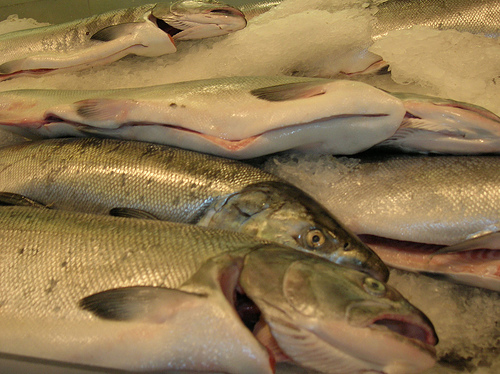
Fresh salmon at market, photo credit Maureen Reilly
Over the holiday season, the US Food and Drug Administration (FDA) issued an administrative finding that may remove one of the last obstacles before the agency approves the sale of genetically modified salmon in grocery stores. Here’s how we got to this point.
In 1995, AquaBounty Technologies, a Massachusetts biotechnology company, filed an application with the FDA to allow its engineered salmon to be the first genetically modified animal in the American food supply. The company had patented AquAdvantage Salmon, a sterile Atlantic salmon female containing a Chinook salmon growth hormone gene, along with a DNA sequence from an ocean pout, a fish resembling an eel. The combination of genetic material allows the modified salmon to grow year-round, reaching market size within 18 months, about twice as fast as conventional salmon.
Commercial fishing interests, including those in Alaska—the state that produces more than 90 percent of all the wild salmon harvested in the US—view genetically modified (GM) salmon as a threat to wild fisheries. Accordingly, the Alaska Congressional delegation is united in opposing these modified salmon.
Among the concerns over GM salmon are their potential to outcompete wild fish. To allay such concerns, AquaBounty plans to produce modified eggs in a facility on Prince Edward Island, Canada, then ship the eggs to a land-based facility in Panama. There the eggs would be raised to market size, and processed into fillets and other fish cuts. The geographically sprawling scheme was sufficient to convince the FDA that the chances of GM salmon escaping into the wild were very low.
Nonetheless, the Alaska Congressional delegation has promised to reintroduce legislation, requiring that GM salmon at least be labeled before sale. The proposed law would be another step in an ongoing campaign to label GM foods in order to provide consumers with an opportunity for informed choice. A California ballot initiative that would have required GM labeling failed at the polls in November 2012. (Supporters of the measure were outspent nearly 7-to-1 by opponents, largely comprised of big agricultural businesses.) But in 2013, supporters in Washington have already gathered more than enough signatures for an initiative to label modified foods that would include GM salmon, among other items.
Time magazine named genetically modified salmon one of the top 50 inventions of 2010, remarking that wild salmon populations are dwindling. But as Senator Mark Begich of Alaska pointed out in the Washington Post, inventing a new fish seems less desirable than more natural measures to preserve wild salmon:
“Want more salmon?” he asked. “Here’s a better idea: Protect its natural habitat, maintain water quality, and manage wild stocks for sustainability.”
The new Congress is just getting organized, but Senator Begich’s official web site contains lists of legislation that he introduced in the last Congress, including one bill that would require labeling of genetically engineered fish, and a second bill that would prevent federal approval of genetically engineered fish. (Washington’s Patty Murray and Oregon’s Ron Wyden were co-sponsors of the labeling bill.)
With regard to AquaBounty’s application, the FDA in December 2012 issued an environmental assessment and a preliminary finding that GM salmon should have “No Significant Impact” on human health and the environment. This could be one of the last steps before the agency approves the marketing of GM salmon. And unless Alaska’s Congressional delegation is successful in requiring labeling, most consumers will have no idea that they’re eating GM salmon. In the interim, the agency opened a 60-day period for public comment on the preliminary finding. Citizens can view relevant documents and submit comments at this website.
John Abbotts is a former research consultant to Sightline who occasionally submits material that Sightline staff turn into blog posts.









civiletti
Labeling would be better than nothing. Banning would be preferable.
Dave
Re: “the chances of GM salmon escaping into the wild were very low”, see http://www.myfwc.com/wildlifehabitats/nonnatives/freshwater-fish/
John Abbotts
Hello folks,
Thank you for your comments. But I hope that the phrase at the end, “submit comments at this website,” did not mislead readers to submit their comments only to Sightline. Rather, clicking on that phrase links to the US FDA web page, where comments can be submitted to the agency electronically. To my knowledge, Sightline does not have an official position on GM salmon, nor the staff or funds [nudge, nudge; hint, hint] to regularly forward comments from members directly to public agencies.
I should confess that I do not have the detailed knowledge nor time to learn enough to poke holes technically in the FDA preliminary finding. However, and again responsibility for these opinions lies with me directly, I do believe that consumers should have the right to know what they are eating. If they can see labels such as “organic” “free range” and “fair trade,” then labels should make clear that foods contain spliced DNA; or more specifically, “invented fish containing DNA from Atlantic salmon, Chinook growth hormone, and eel-like fish promoter sequence.”
In addition, if Sightline editors will allow me to rattle on, I do not have the expertise to evaluate whether eating GM salmon poses human health risks. Nonetheless, I do believe the term “Frankenfish” is apt, because the GM salmon grows much larger than the natural species. Timothy Egan, a Northwest journalist and author, published an opinion piece in the New York Times in March 2011, at http://opinionator.blogs.nytimes.com/2011/03/17/frankenfish-phobia/?hp
Egan argues persuasively for restoration of natural salmon habitat, and toward the middle of the article, he includes a photo comparing the GM salmon to its original source, the Atlantic salmon. This photo came from the “inventing” company, but it has gone viral in the news media. To me, the GM salmon looks Gigantic compared to its natural counterpart.
Again, I appreciate the comments.